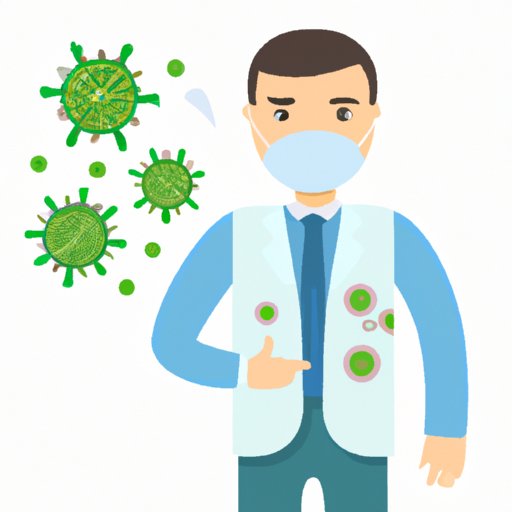
Introduction
Viruses are tiny infectious agents that can cause a wide range of diseases in humans, animals, and plants. Unlike bacteria, fungi, and other microbes, they cannot reproduce on their own and must infect living cells to replicate. Although many viral infections cause only mild symptoms, some viruses, such as HIV, Ebola, and SARS-CoV-2 (the virus that causes COVID-19), can lead to severe and sometimes deadly illnesses. In this article, we will delve into the mechanics of viral infections and explore the ways that different viruses cause diseases. We will also discuss how the immune system responds to viral infections and how vaccines can prevent them.
The Inner Workings of Viruses: How They Cause Disease
Viruses are made up of genetic material, either DNA or RNA, enclosed in a protein shell called a capsid. Some viruses, including SARS-CoV-2, also have a lipid envelope that helps them enter cells. To infect a host cell, a virus must first attach to its surface, usually to a specific receptor molecule. Once attached, the virus injects its genetic material into the cell and hijacks the cell’s machinery to produce new virus particles. The newly made viruses can then infect other cells and continue the cycle of infection.
Viruses use a variety of strategies to evade the immune system, which is the body’s defense against infections. For example, some viruses can mutate rapidly, making it difficult for the immune system to recognize and target them. Other viruses, such as HIV, can hide inside cells and avoid detection. Some viruses can also interfere with the immune system’s signaling pathways, preventing the production of antibodies and other immune molecules. These strategies allow viruses to persist in the body and cause chronic infections.
Breaking Down the Stages of Viral Infection and Its Impact on the Body
A typical viral infection progresses through five stages: incubation, prodromal, acute illness, recovery, and convalescence. During the incubation stage, the virus replicates inside the body without causing any symptoms. The length of the incubation period varies depending on the virus and the individual’s immune system. During the prodromal stage, the person may experience mild symptoms such as fatigue, fever, and muscle aches. This stage signals that the virus has started to spread and the immune system is mounting a response.
The acute illness stage is when the person experiences the full-blown symptoms of the disease, such as coughing, sneezing, and diarrhea. The severity of the symptoms depends on the type of virus and the person’s underlying health. Some viral infections, such as influenza, can cause severe symptoms that require hospitalization, while others, such as the common cold, cause only mild symptoms. The recovery stage is when the immune system starts to clear the virus from the body. Finally, during the convalescence stage, the person recovers from the illness and returns to their normal activities.
During each stage of infection, viruses can attack different organs and systems in the body. For example, respiratory viruses such as SARS-CoV-2 primarily affect the lungs, while noroviruses primarily affect the gastrointestinal tract. Some viruses, such as herpes simplex virus and varicella-zoster virus, can remain dormant in the body for years before reactivating and causing disease.
Understanding the Role of the Immune System in Fighting off Viral Infections
The immune system plays a critical role in detecting and eliminating viruses from the body. When a virus infects a cell, it triggers an immune response that involves multiple components, including antibodies, T cells, and cytokines. Antibodies are proteins produced by B cells that can recognize and bind to specific virus particles, marking them for destruction by other immune cells. T cells are white blood cells that can recognize and kill virus-infected cells directly. Cytokines are signaling molecules that help coordinate the immune response and regulate inflammation.
During a viral infection, the immune system must balance the need to eliminate the virus with the need to minimize damage to the body. If the immune response is too weak, the virus can continue to replicate and cause more damage. If the immune response is too strong, it can cause excessive inflammation and tissue damage, as seen in severe cases of COVID-19.
Vaccines work by stimulating the immune system to produce antibodies and T cells that can recognize and eliminate specific virus particles. Vaccines contain either inactivated or weakened virus particles or parts of the virus, such as proteins or genetic material. When a person receives a vaccine, their immune system recognizes these foreign particles and produces a response that can protect against future infections. Vaccines have been highly effective in eradicating some viral diseases, such as smallpox, and controlling others, such as measles.
The Vicious Cycle of Viral Replication and Disease Progression
As viruses replicate and spread in the body, they can cause more damage to the host. For example, influenza viruses can damage the lungs and predispose the person to secondary bacterial infections. HIV attacks the immune system, leaving the person vulnerable to other infections and cancers. Some viruses, such as hepatitis B and C viruses, can cause chronic liver damage and increase the risk of liver cancer.
The severity of viral infections is also influenced by viral load, which refers to the amount of virus present in the body. Higher viral loads are associated with more severe symptoms and a greater risk of transmission to others. Viral load can be reduced through antiviral medications, which can inhibit viral replication and slow the progression of the disease.
In some cases, viral infections can also have long-term consequences. For example, some people who recover from COVID-19 report persistent symptoms such as fatigue, brain fog, and muscle weakness, a condition known as “long COVID.” Other viruses, such as human papillomavirus (HPV), can cause cancers years after the initial infection.
Examining the Diverse Ways that Different Viruses Induce Disease
There are many different types of viruses that can cause diseases in humans. Some viruses, such as the rhinoviruses that cause the common cold, are relatively harmless and self-limited, while others, such as ebolaviruses, can be deadly. Some viruses, such as influenza viruses, can mutate rapidly and cause seasonal outbreaks, while others, such as herpesviruses, can remain dormant in the body and cause recurrent infections.
The virulence, or severity, of a virus depends on many factors, including its ability to evade the immune system, its mode of transmission, and the host’s underlying health. For example, COVID-19 is highly transmissible and can cause severe illness in people with underlying health conditions, while measles is highly contagious and can cause severe complications even in healthy people.

Exploring the Link between Viral Infections and Chronic Diseases
Some viral infections can lead to chronic diseases, which are conditions that persist for months or years and can have long-term health consequences. For example, hepatitis B and C viruses can cause chronic liver disease and increase the risk of liver cancer. Human papillomavirus (HPV) can cause cervical, anal, and other cancers. HIV can lead to acquired immunodeficiency syndrome (AIDS), a condition characterized by severe immune suppression and an increased risk of infections and cancers.
One way that viruses can cause chronic diseases is by inducing chronic inflammation. Inflammation is a normal immune response to infections and injuries, but when it persists for a long time, it can damage tissues and increase the risk of cancer and other diseases. Some viruses, such as hepatitis B and C viruses, can trigger chronic inflammation in the liver, leading to fibrosis, cirrhosis, and liver cancer. Other viruses, such as human papillomavirus, can induce chronic inflammation in the cervix or anus, leading to cancer.
Highlighting the Importance of Vaccination in Preventing Viral Diseases
Vaccines are one of the most effective ways to prevent viral diseases. They can protect individuals and communities from outbreaks and reduce the burden of disease on healthcare systems. Vaccines work by stimulating the immune system to produce a protective response against specific viruses. They have been highly successful in controlling and eradicating many viral diseases, such as smallpox, polio, and measles.
Despite their proven effectiveness, vaccines can be controversial and subject to misinformation and myths. Some people may be hesitant to receive vaccines due to concerns about their safety or efficacy. However, vaccines undergo rigorous testing and monitoring to ensure their safety and effectiveness. The benefits of vaccines far outweigh the risks and can help protect individuals and communities from preventable diseases
Examples of successful vaccination campaigns include the global eradication of smallpox, the near-elimination of polio, and the sharp decline in measles cases in many countries. In the case of COVID-19, vaccines have been developed and approved in record time, offering hope that the pandemic can be controlled and eventually brought to an end.
Conclusion
Viral diseases can have a significant impact on human health and well-being, ranging from mild symptoms to severe and life-threatening illnesses. Understanding the inner workings of viruses and the mechanisms by which they cause disease is essential for developing effective treatments and prevention strategies. Vaccines are one of the most important tools in preventing viral diseases, and their proven safety and effectiveness should be communicated widely. By taking action to prevent viral infections, we can protect ourselves and others and reduce the burden of disease on society.




